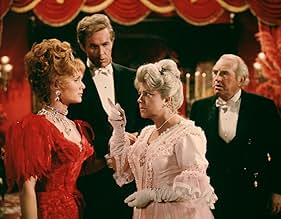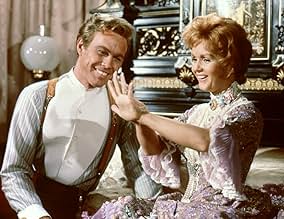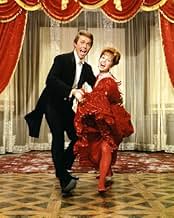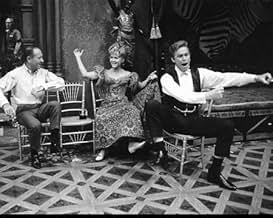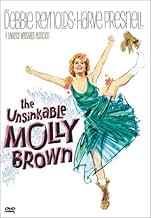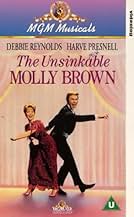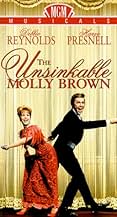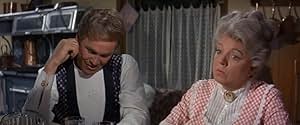Voglio essere amata in un letto d'ottone
Titolo originale: The Unsinkable Molly Brown
VALUTAZIONE IMDb
6,6/10
4478
LA TUA VALUTAZIONE
Aggiungi una trama nella tua linguaA poor, uneducated mountain girl leaves her cabin in search of respect, a wealthy husband, and a better life in this fictionalized biopic of Margaret "Molly" Brown, who survived the 1912 sin... Leggi tuttoA poor, uneducated mountain girl leaves her cabin in search of respect, a wealthy husband, and a better life in this fictionalized biopic of Margaret "Molly" Brown, who survived the 1912 sinking of the RMS Titanic.A poor, uneducated mountain girl leaves her cabin in search of respect, a wealthy husband, and a better life in this fictionalized biopic of Margaret "Molly" Brown, who survived the 1912 sinking of the RMS Titanic.
- Regia
- Sceneggiatura
- Star
- Candidato a 6 Oscar
- 5 vittorie e 13 candidature totali
Recensioni in evidenza
What a fun movie! Debbie Reynolds does a wonderful job portraying Molly Brown, a poor, uncultured country girl who "makes good," but then finds herself having to fight (none too successfully) for acceptance among the rich crowd she finds herself suddenly thrown into. Always rising when she's down (unsinkable in other words) there's also a sense of discovery involved for Molly, as she finally comes to understand in a wonderfully dramatic moment in an otherwise hilarious film that even among her wealthy and regal European friends she is accepted because they find her amusing, and not because she's really accepted as one of them. The title of the movie, of course, comes specifically from the real-life Molly Brown's experience in surviving the Titanic disaster, as she returns home after making this discovery.
Yes, the movie is undoubtedly full of tall tales. But it's full of wonderful songs (Harve Presnell as Johnny Brown has a marvellous singing voice), pretty good acting and just a general sense of fun. Well worth the watching.
Yes, the movie is undoubtedly full of tall tales. But it's full of wonderful songs (Harve Presnell as Johnny Brown has a marvellous singing voice), pretty good acting and just a general sense of fun. Well worth the watching.
6B24
I had the pleasure of accompanying my great aunt and one of her contemporaries to the opening of this movie in Denver in 1964. Because they had known the old girl herself (the real Mrs. Margaret Brown, that is) back in the early years of the century, both in Leadville and Denver, they were keen on seeing what Hollywood and Debbie had done with the story.
I remember vividly watching their reactions turn from initial pleasure with the opening number to puzzlement when Debbie started to chew the scenery and behave like, well, Debbie Reynolds. This was followed by Ed Begley and the boys in the saloon hooting it up, and the two old ladies next to me started to frown a bit and whisper something to the effect that "it was not like that at all." They were becoming quite restless until the Denver bits began, but they seemed to accept the remainder of the story with a good deal of resignation that it was all just good fun and nonsense, and wasn't that what going to the movies was all about?
Afterward, as we strolled over to the Brown Palace for dinner, they regaled me with a complete history of the real Mrs. Brown and the many mutual friends they had enjoyed meeting at that same venue from roughly 1895 to 1915 when they were themselves just being presented into Denver society. I learned, among other things, that Mrs. Brown was considered an eccentric but generally well-liked and articulate woman who, despite never really being accepted at the toniest levels, became a legend in her own time after the Titanic episode. That part of the story was not only true, but actually a larger-than-life experience, the details of which they agreed should have been featured more profoundly in the film version.
The next time I drove down Wadsworth Blvd. and saw Mrs. Brown's "Summer House," a rather grand Victorian edifice like the better known one in the center of Denver, I tried to picture Debbie Reynolds in that setting and could not quite fit the two together. That in spite of the fact that Debbie herself grew up in El Paso at the southern end of the same Rocky Mountains that rise northward through Colorado.
I remember vividly watching their reactions turn from initial pleasure with the opening number to puzzlement when Debbie started to chew the scenery and behave like, well, Debbie Reynolds. This was followed by Ed Begley and the boys in the saloon hooting it up, and the two old ladies next to me started to frown a bit and whisper something to the effect that "it was not like that at all." They were becoming quite restless until the Denver bits began, but they seemed to accept the remainder of the story with a good deal of resignation that it was all just good fun and nonsense, and wasn't that what going to the movies was all about?
Afterward, as we strolled over to the Brown Palace for dinner, they regaled me with a complete history of the real Mrs. Brown and the many mutual friends they had enjoyed meeting at that same venue from roughly 1895 to 1915 when they were themselves just being presented into Denver society. I learned, among other things, that Mrs. Brown was considered an eccentric but generally well-liked and articulate woman who, despite never really being accepted at the toniest levels, became a legend in her own time after the Titanic episode. That part of the story was not only true, but actually a larger-than-life experience, the details of which they agreed should have been featured more profoundly in the film version.
The next time I drove down Wadsworth Blvd. and saw Mrs. Brown's "Summer House," a rather grand Victorian edifice like the better known one in the center of Denver, I tried to picture Debbie Reynolds in that setting and could not quite fit the two together. That in spite of the fact that Debbie herself grew up in El Paso at the southern end of the same Rocky Mountains that rise northward through Colorado.
This is not a review, but an inquiry. Does anyone know who the real-life baby was that portrayed Molly as a baby in the beginning of the movie going over the rapids in a cradle? I saw a very old "filler" once on TCM which featured swim instruction for very young children, some as young as 12 months. The instructor had them swimming to the pool bottom to retrieve items as well as racing each other to see who reached the other side first. I believe early swim instruction had gained some measure of popularity in California during the 30s. Most of the footage of the rapids was of a dummy. Other footage was of the baby in a water tank on a sound stage with footage of rapids being shown in the background. The final few seconds of that scene show the cradle overturning very close to shore and spilling the baby out. The baby then swims to shore and crawls out - that part is real. I sure would like to know who that baby was. It was precious!
"The Unsinkable Molly Brown" made its debut on Broadway in 1960. Tammy Grimes, as the Molly Brown of the title, received, perhaps, the best reviews of her acting career. When it was made into an MGM musical, Miss Grimes, lost her creation to Debbie Reynolds, who had a bigger name and was a favorite of the movie going public.
Meredith Wilson, the man behind another hit, "The Music Man", created a musical comedy that showcased a fictionalized account of the larger than life character of Molly, a woman who went from humble beginnings to bigger, and better things. As a matter of fact, she was truly "unsinkable" as proved by having survived the Titanic disaster.
Not having seen this film for quite some time, didn't quite make it for this viewer, on a second viewing, in spite of glowing comments from other IMDb contributors. However, it must be noted, our memory of having seen it before was more positive than the impression we got in watching it again. Part of the problem is the plot, which is silly, in the way the material is presented. Then again, this film has a dated feeling.
Debbie Reynolds threw herself into the role of Molly with gusto. It's one of her best achievements in the movies, and it should be recognized. Herve Presnell, who played Johnny Brown on Broadway, seemed destined for bigger and better things, as he shows here with his handsome looks and powerful singing voice. The cast includes several character actors that enhance the movie, notably, Ed Begley, Hermione Baddeley, Jack Krushen and Martita Hunt, among others.
The film could be seen as a curiosity, although it shows its age. The songs, with only a few exceptions don't have the quality of other Meredith Wilson's work. Only a couple of songs stay with the viewer after all is said and done. Charles Walters' direction was not too inspired and perhaps that seems to be the basic flaw with this "Molly".
Meredith Wilson, the man behind another hit, "The Music Man", created a musical comedy that showcased a fictionalized account of the larger than life character of Molly, a woman who went from humble beginnings to bigger, and better things. As a matter of fact, she was truly "unsinkable" as proved by having survived the Titanic disaster.
Not having seen this film for quite some time, didn't quite make it for this viewer, on a second viewing, in spite of glowing comments from other IMDb contributors. However, it must be noted, our memory of having seen it before was more positive than the impression we got in watching it again. Part of the problem is the plot, which is silly, in the way the material is presented. Then again, this film has a dated feeling.
Debbie Reynolds threw herself into the role of Molly with gusto. It's one of her best achievements in the movies, and it should be recognized. Herve Presnell, who played Johnny Brown on Broadway, seemed destined for bigger and better things, as he shows here with his handsome looks and powerful singing voice. The cast includes several character actors that enhance the movie, notably, Ed Begley, Hermione Baddeley, Jack Krushen and Martita Hunt, among others.
The film could be seen as a curiosity, although it shows its age. The songs, with only a few exceptions don't have the quality of other Meredith Wilson's work. Only a couple of songs stay with the viewer after all is said and done. Charles Walters' direction was not too inspired and perhaps that seems to be the basic flaw with this "Molly".
I was a young teenager when I first saw THE UNSINKABLE MOLLY BROWN. I
never put Debbie Reynolds in the same class as her bigger contemporaries-- Audrey Hepburn, Elizabeth Taylor, Doris Day, etc. Reynolds always managed
to charm me, even in tough roles like THE RAT RACE. She's wonderful in
SINGIN' IN THE RAIN, but that's more supporting. In the 50s, she appeared in lots of fluffy movies such as TAMMY AND THE BACHELOR and as the decade
ended, she was a popular leading lady entering a decade that wouldn't be kind to the well-established studio stars. Molly Brown was a role to show that she could do it all--act, sing, dance, and demonstrate her remarkable energy. I fell in love the movie from the first frame and it's been one of my very favorites ever since. I own the DVD (after replacing my VHS edition). The choreography by
Peter Gennaro won't set any new standards, but it's athletic and exciting,
nowhere better than in the big party scene where Molly is showing off the
European royalty to Denver society. You can't help but get caught up in the
sheer joyousness of what's happening on screen.
Harve Presnell is a handsome presence as Molly's husband, Johnny Brown.
His handsome baritone is a pleasure to hear. The rest of the cast is excellent, and would be one of the last and one of the most lavish of MGM's big studio
musicals.
I've seen the film innumerable times. If you don't like musicals, MOLLY BROWN won't change your mind. But if you do, this lively story of a dirt-poor country girl who marries a miner and gets filthy rich and becomes famous for her heroics
helping survivors of the TITANIC, is pure delight. Gene Kelly and Donald
O'Connor were the center of attention in SINGIN' IN THE RAIN. Debbie
deserved one film to be remembered for herself and this is it.
never put Debbie Reynolds in the same class as her bigger contemporaries-- Audrey Hepburn, Elizabeth Taylor, Doris Day, etc. Reynolds always managed
to charm me, even in tough roles like THE RAT RACE. She's wonderful in
SINGIN' IN THE RAIN, but that's more supporting. In the 50s, she appeared in lots of fluffy movies such as TAMMY AND THE BACHELOR and as the decade
ended, she was a popular leading lady entering a decade that wouldn't be kind to the well-established studio stars. Molly Brown was a role to show that she could do it all--act, sing, dance, and demonstrate her remarkable energy. I fell in love the movie from the first frame and it's been one of my very favorites ever since. I own the DVD (after replacing my VHS edition). The choreography by
Peter Gennaro won't set any new standards, but it's athletic and exciting,
nowhere better than in the big party scene where Molly is showing off the
European royalty to Denver society. You can't help but get caught up in the
sheer joyousness of what's happening on screen.
Harve Presnell is a handsome presence as Molly's husband, Johnny Brown.
His handsome baritone is a pleasure to hear. The rest of the cast is excellent, and would be one of the last and one of the most lavish of MGM's big studio
musicals.
I've seen the film innumerable times. If you don't like musicals, MOLLY BROWN won't change your mind. But if you do, this lively story of a dirt-poor country girl who marries a miner and gets filthy rich and becomes famous for her heroics
helping survivors of the TITANIC, is pure delight. Gene Kelly and Donald
O'Connor were the center of attention in SINGIN' IN THE RAIN. Debbie
deserved one film to be remembered for herself and this is it.
Lo sapevi?
- QuizAs with most Hollywood biopics, there are liberties taken with the real story, most notably in that Margaret (Molly) and J.J. never reconciled. They separated in 1909, although they remained good friends who cared deeply for each other until his passing. She was also not quite the social outcast depicted in the film. Other aspects of her life that were missing from the movie: they had two children, a son and daughter. Margaret Brown was a passionate social crusader and philanthropist; she was a champion of women's rights, including education and the vote. She championed workers' rights, historic preservation, education and literacy, and child welfare, including helping to found the modern juvenile court system. After the sinking of the Titanic, she was noted for her efforts to commemorate the heroism of the men aboard the ship. After WWI, she helped to rebuild France and to aid wounded soldiers, and received the French Legion of Honor. She also ran twice for the U.S. Senate. She died in 1932.
- BlooperWhen Molly first meets John, in the 1880s, they look at some picture postcards she has with her. The picture occupies one entire side of each card, but postcards of this type were not available in the USA until 1907.
- Citazioni
Molly Brown: Nobody wants to see me down like I wants to see me up.
- Curiosità sui creditiintroducing Harve Presnell
- Versioni alternativeIn the past, TCM has shown a version with Overture and Exit Music that ran 135 minutes. It also had a slightly different aspect ratio.
- ConnessioniEdited from Titanic (1953)
- Colonne sonoreOverture (Belly Up to the Bar, Boys/I Ain't Down Yet/I'll Never Say No/Colorado, My Home)
(uncredited)
Music and Lyrics by Meredith Willson
Performed by Robert Armbruster and The MGM Symphony Orchestra (as the MGM Studio Orchestra)
I più visti
Accedi per valutare e creare un elenco di titoli salvati per ottenere consigli personalizzati
Dettagli
Botteghino
- Lordo Stati Uniti e Canada
- 13.167.200 USD
- Tempo di esecuzione2 ore 8 minuti
- Colore
- Proporzioni
- 2.35 : 1
Contribuisci a questa pagina
Suggerisci una modifica o aggiungi i contenuti mancanti

Divario superiore
By what name was Voglio essere amata in un letto d'ottone (1964) officially released in India in English?
Rispondi

